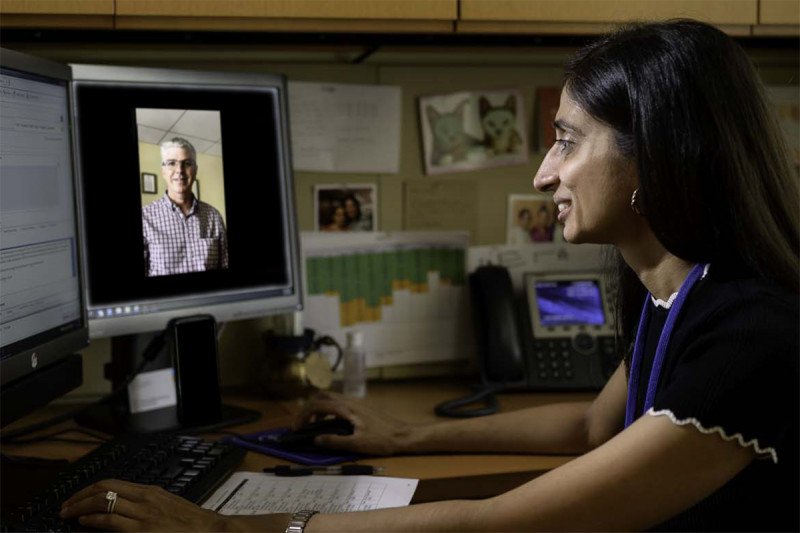
People with cancer and their doctors build a strong relationship talking face-to-face, laying a foundation of trust and open communication.
These days, you can meet your Memorial Sloan Kettering doctor face-to-face for many of your visits without leaving your home. More and more, successful visits are done by telemedicine, when you and your doctor see and talk with each other using a computer, tablet, or smartphone. These visits can reduce the stress, inconvenience, and expense of travel.
So how can you make your telemedicine visit a success?
MSK medical oncologist Nitya Raj cares for people with gastrointestinal cancers, including neuroendocrine tumors, colorectal cancer, and pancreatic cancer. Here, she shares key tips for patients that are based on her own telemedicine visits with the people she cares for as well as conversations with dozens of other doctors.
1. Treat a telemedicine visit just like a regular visit.
I tell people to think of a telemedicine visit just as they do a face-to-face conversation in my office. We can do almost all the same things during a telemedicine visit that we would do sitting together in my clinic, including exams.
- People should wear the same clothes they would for an office visit, as a physical examination may be needed.
- They should write down any questions, concerns, or symptoms before the visit. That reduces the stress of trying to remember what you want to tell your doctor and makes the visit more efficient.
- I tell people to find a small area of their home that is quiet, private, and if possible, has a bright light. It’s only needed for a short time. Making sure they can focus just on the conversation with their doctor is important.
2. Feel free to include another person if you want.
I encourage people to bring a family member or friend to all visits, including telemedicine visits. They can provide moral support and be a second set of eyes and ears to take notes and ask questions.
During a telemedicine visit, having another person present can also help the doctor. For instance, if a person has swollen ankles or I need to see inside the mouth, it can be challenging for the patient to get the camera into position. Another person in the room can move the laptop or cell phone and make it easier for everyone.
A caregiver or friend can also join the visit using a computer or smartphone if they can’t be there in person. At MSK, we often use technology to connect the people we care for with friends or family members because we know how much that support means to people dealing with cancer.
3. Don’t stress about the technology.
People can get anxious about whether they will need to troubleshoot if there is a problem with a tech device or if the video feed goes down. Don’t worry!
If the video connection isn’t great, ask your doctor to do the exam while it’s good, and switch to a phone conversation when needed. There are lots of ways to work around problems if the technology doesn’t work perfectly. Your care team will have great ideas if needed.
4. Some parts of telemedicine visits are better than office visits.
Some patients tell me they feel calmer and more relaxed being in their own homes.
I can also get new insights into their condition. For instance, when a patient says: “I’m having trouble getting up the stairs to my bedroom,” I ask them to show me the stairs if they are using a laptop or cell phone. Seeing people in their home environment is really helpful as a doctor.
5. Don’t worry about what we can’t do during a telemedicine visit.
There are some procedures, like listening to your heart and lungs with a stethoscope, that require an office visit. But when we identify a patient as being appropriate for a telemedicine visit, we are very confident we can learn everything we need.
Sometimes we also ask patients to keep a log of important vital signs, like taking their weight once a day. And some patients have blood pressure monitors at home, which can be helpful.
People should understand that telemedicine visits are useful for people at every stage of their journey, whether they are currently in treatment or are finished with their cancer care, or they have just been diagnosed. Most of the things we would learn about a patient in an office visit are communicated just as well in a telemedicine visit.
6. Relax, we’re here to help!
I’ve been really pleased with the quality of care I’m able to provide with telemedicine visits. And my patients tell me that these kinds of visits reduce the burden of travel, especially for people who have frequent appointments.
I’ve also spoken with many doctors about telemedicine and what I hear again and again is that their experiences with the people they care for are very positive.
The use of telemedicine definitely increased during the COVID-19 pandemic to reduce exposure. However, the doctors and patients I’ve talked to agree that it should be a big part of normal medical practice from now on. Doctors are thrilled to have more ways to care for their patients and improve their health and quality of life.

